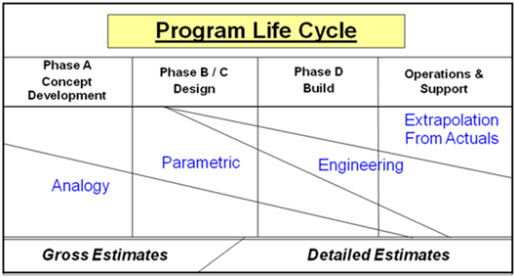Cost Estimating and Analysis Overview
The needs of the Cost Estimating and Analysis community are as varied as the projects being undertaken at NASA. NASA has a wide range of mission requirements and a variety of expectations and tools that are used to plan and execute those requirements. Cost estimators and cost analysts may be asked to support activities ranging from the development of estimates for competitive proposals to the development of independent estimates. These estimates can be used either for the selection of proposals or the approval to proceed to the next life-cycle phase. NASA requires cost estimating for major acquisition programs. Resources are increasingly scarce, and space systems are increasingly expensive. Informed decisions are critical.
NASA and many external organizations are consumers of cost estimates and analyses. The Agency needs estimates for Project Office formulation and implementation phases, non-advocate cost estimates, source selections, what-if exercises, affordability studies, economic analyses, and analyses of alternatives, as well as to support numerous types of decisions related to projects. System cost must be a design variable to help focus on major cost drivers during design and to challenge estimates that deviate strongly from history. The cost estimating process defined in this handbook will provide the decision maker with a clear understanding of the cost risk inherent in the project, cost of alternatives within the project, and information to make resource allocation decisions. Once the decision is made to proceed with the project, cost estimates provide management with critical cost-risk information to improve the control of resources in the present and the future as well as provide insight into the impact of project changes on the program budget. The cost estimating process must therefore be adaptable and flexible while holding firm to the principles, objectives, and practices of cost estimating. The following groups are informed by cost estimates:
- Projects, programs, Centers, Mission Directorates, and the Agency as a whole
- External stakeholders (e.g., Congress and the Office of Management and Budget [OMB])
- Auditors (e.g., the Government Accountability Office [GAO] and the NASA Office of Inspector General [OIG])
- Taxpayers
Robust cost analysis is critical to a project’s health, though rendering credible cost estimates can be challenging for PP&C. The inability to properly capture technological nuances, task complexity, schedule details, changes in requirements, or risk scenarios reduces the predictive power and usefulness of estimates. However, according to an Inspector General report from 2012, the primary reason for unrealistic estimating at NASA has proven to be its culture of optimism. Historically, many Agency programs and projects have overestimated their ability to predict and manage risk, a reality that has thwarted their intent to complete their missions on time and under budget. PP&C must address this optimism bias, in part, by constructing defendable cost estimates that maximize objectivity in data, presentation, and methods appropriate to the maturity of the project while adhering to best practice, the discussion of which comprises the majority of this section.



























